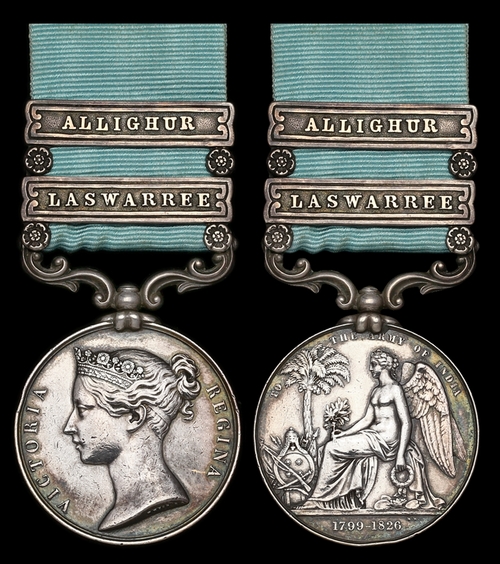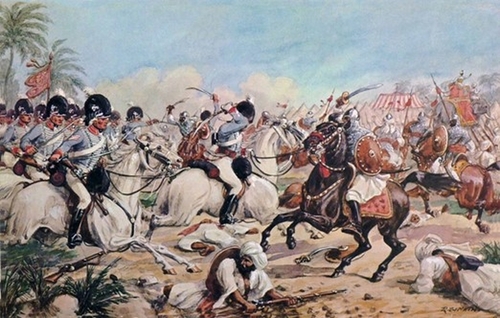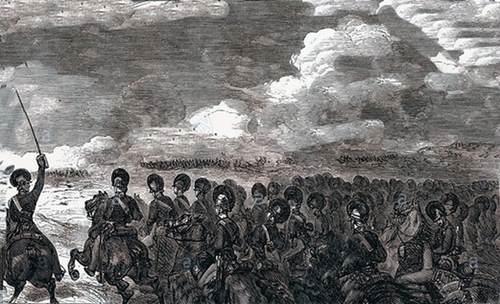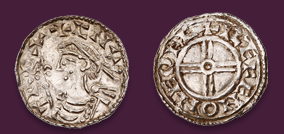Auction: 25002 - Orders, Decorations and Medals
Lot: 15
'Through the courtesy of the Sergeant-Major we obtained an interview with the oldest pensioner in Chelsea Hospital. We were conducted into the detached premises on the west side of the hospital which is appropriated to the sick and infirm pensioners. In a large and airy room, ranged on each side, are several small beds occupied by the infirm. Near the fireplace, in an armchair, sat the oldest veteran referred to, with his head drooping as if asleep. He looked remarkably healthy; the principal evidence of his age being a considerable tremulousness resembling palsy. He has recently been in the habit of walking about the locality of the hospital; but it is deemed advisable not to allow him to leave the premises, for his personal safety. From questions put to him through his nurse and the Sergeant-Major, we ascertained the following facts of his history.
His name is Richmond. He was born at Tamworth, Staffordshire, in March 1755, and he is therefore now in the 105th year of his age. He has been twenty-four years and a half in the public service, of which twelve were spent in India, three years at the Cape, and the rest at Hainalt, in Belgium, etc. He was severally in the 16th, 28th and 29th Light Dragoons. Richmond was at the Mahratta War, at the storming of the fort of Allighur, in the north of India, in 1803, under General Lake and Colonel Monson. This succeeded the important battle of Assaye, gained by Sir Arthur Wellesley, and was shortly followed by the capture of Delhi, and the vanquishing of Perron, the French General. The old veteran was also engaged at Laswarree, Agra, and Bhurtpore. His medal has bars for Allighur and Laswarree.
It is very gratifying to see the care and attention bestowed upon him and his fellow pensioners, especially considering that though the old man's sight, hearing, memory, etc., are good, he is unable to feed himself. He is able to walk about without the aid of a stick, and in other respects his powers and faculties are remarkably good. None of his fellow prisoners approach his age within fifteen years.'
So reported the Illustrated Berwick Journal of 17 September 1859.
The remarkable - and rare - Army of India Medal awarded to Private Nathaniel Richmond, 29th Light Dragoons, who is said to have had two horses shot from under him at the battle of Laswarree in November 1803
Yet his true claim to fame was the fact he was declared 'the oldest soldier of the British Army', living until the age of 108 as an in-pensioner at the Royal Hospital, Chelsea
Army of India 1799-1826, 2 clasps, Allighur, Laswarree (N. Richmond, 29th. Lt. Dragns.), short hyphen reverse, officially impressed naming, edge bruising and light contact marks, otherwise good very fine
Provenance:
Glendining's, February 1963.
Just eight Medals were issued with this combination of clasps, including five to the 29th Light Dragoons; approximately 66 clasps for Allighur and 100 clasps for Laswarree were issued to European recipients.
Nathaniel Richmond was born in Tamworth, Staffordshire in March 1755 and was a collier by trade on enlisting in the16th Light Dragoons in April 1793, aged 38 years. And he was quickly embarked for Ostend, from whence the regiment was deployed in the Flanders campaign, not least in the province of Hainaut.
In April 1795, Richmond transferred to the 28th Light Dragoons, with whom he was embarked for Cape Town in March 1796. And he was thus employed when a squadron of Dutch ships attempted to retake the settlement in August 1796. Once again, however, in October 1798, Richmond transferred to another regiment, on this occasion to the 29th Light Dragoons, who were stationed in India. Here, then, the commencement of his part in the Second Mahratta War.
First up was the battle of Allighur on 4 September 1803, in which Richmond is reported to have had a 'narrow escape' from a shell burst in the right centre squadron of the 29th Light Dragoons (the North Devon Journal of 28 May 1863, refers). And he undoubtedly saw further action at the capture of Agra in the following month.
But his most memorable encounter was surely at Laswarree on 1 November 1803, when, according to General Lake, Daulat Scindia's veteran infantry 'fought like devils or rather like heroes.' And thrust into the forefront of that desperate engagement were the likes of Richmond and the 29th Light Dragoons, who were greeted by a tempest of fire from the Mahrattas. Literally 'riding hell for leather' they rushed the enemy's guns, scattering and sabring the gunners, before breaking the first line of infantry. They then pressed on to the second line, sending its right flank reeling back in disorder, prior to reforming under fire and charging the Mahratta cavalry.
Such daring came at a cost, however, the 29th suffering a loss of four officers and 15 other ranks killed, and six officers and 39 ranks wounded. Richmond is said to have had two horses shot from under him (the North Devon Journal of 28 May 1863, refers). Nor was the fighting over, the regiment witnessing further action in Lake's pursuit of Scindia's army, at Bhurtpore and elsewhere.
On being discharged in September 1807, and having served in the 11th Veterans Battalion, Richmond retired to his native Staffordshire on a pension of one shilling a day, but in September 1847 he was admitted as an in-pensioner at the Royal Hospital, Chelsea. And there he remained until his death in May 1863, aged 108 years. According to the previously quoted North Devon Journal, 'he was buried at Brompton Cemetery, followed by his brave companions in arms, and an only niece, an aged woman 82 years old.'
For further details see Tony Conroy's excellent article 'Nathaniel Richmond: a 108-year-old cavalry veteran', which was published in the O.M.R.S. Journal in June 2021 (Vol. 60, Number 2); sold with copied research, including a copy of the journal.
Subject to 20% VAT on Buyer’s Premium. For more information please view Terms and Conditions for Buyers.
Sold for
£9,500
Starting price
£4000









